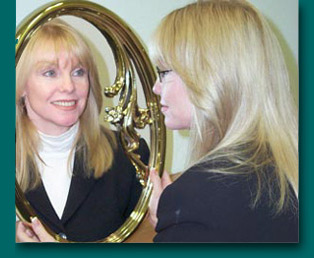Eye Witness to
Lasik
"For individuals with
Myopia (Nearsightedness), Hyperopia (Farsightedness), or Astigmatism there is
now a way to improve your vision. LASIK (Laser in-Situ-Keratomileusis) is a
technique that reshapes the surface of the cornea with an excimer laser, thus
correcting vision problems. LASIK is outpatient surgery performed in Dr.'s
office lasting approximately five to ten minutes." (from a lasik surgeon's
website.)

Look
into your future without glasses!
Glasses
could be a thing of your past with LASIK (laser vision correction)
surgery performed by -
Nationwide Vision
|
"Then
the chilling truth set in: because I didn't look. I chose to undergo a
medically unnecessary procedure for vanity and convenience without the
slightest bit of due diligence. I didn't scrutinize the doctor, the
clinic, the procedure or other people's results. I relied on the success
stories of a few acquaintances, the ads I saw on TV and the assurances
of a doctor I knew only casually...Unbelievably I had agreed to an
invasive surgery without learning even the most basic information."
(Martha Gurshun - Self Magazine "The Surgery I regret" Sept 2001) |
Martha Gurshun, who had
lasik surgery for $4000 (self pay), sustained - what she later found out was a
common complication after this procedure - dry eyes which give her constant pain
(has to put in drops every 20 minutes and also wakes up during the night to put
in drops and it's still painful). She never did enjoy life without
glasses. She lost her visual acuity (she writes "My vision isn't
crisp or clear and I can't read easily).
Martha is also no longer able to see well enough to drive a car. The eye drops
which cut down the pain cost her $50 a bottle.
Lasik is a type of eye surgery in
which they use a laser to cut a flap off the cornea which is the clear area on
top of your eyeball which projects the incoming light on the retina, a sort of
screen in the back of your eye. After they lift the flap, then they use
the laser to cut off a tiny bit of the cornea in order to make it of a shape
which will supposedly refract the light rays better and thus, make you see
better. Then they replace the flap.
The entire procedure takes about
10-15 minutes for each eye and the patient has minimal pain afterward. The
surgery is done because people don't want to wear glasses. Sounds almost
perfect, right?
Reality is a bit harsher. Many
people do not have the same acuity of vision after lasik (clarity) and some
studies suggest that patients do not see as well in situations of low contrast,
such as at night or in fog, after treatment as compared to before treatment.
Worse yet, there is
no guarantee that the procedure will give you 20-20 vision or that this
improvement in vision will last. That is, you might have to have the procedure
done again in a few years or you might need more than one procedure to correct
your vision well enough to not require glasses. Lasik does not work well
on very near sighted people or older people.
And then, there are the
complications. Lasik has a 5 percent chance of things like dry eye
which is extremely painful even WITH using the special and EXPENSIVE drops (5
individuals out of every 100 surgeries) and a 1 or 2 percent chance of blindness
(1-2 individuals out of every 100 surgeries). The long term complications are
not known however, individuals receiving RK, the predecessor of lasik,
showed a high percentage of cataracts and glaucoma 15-20 years after the
surgery. In fact, one of the risks for the development of glaucoma, a
painful disorder which can cause blindness, is any eye surgery!
Some figures: 1 million lasik
procedures are expected to be performed this year.
55,000 individuals will have
similar complications to the author who wrote the words above quoted.
10000 or 20000 individuals will
lose their vision either fully or partially, from the surgery.
Martha writes: "If
I had sought out the simplest facts - the ones I know now - I would have
realized that no potential promise of increased convenience or enhanced beauty
is worth risking my eyes, no matter how remote the risk."
Article by Sue Joan
Support
for individuals who have had complications from lasik
Self Magazine: www.self.com
back to articles
Healthread!
